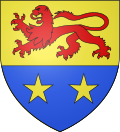You can help expand this article with text translated from the corresponding article in French. (December 2008)Click [show] for important translation instructions.
|
Boofzheim Boofze | |
|---|---|
 A house in Boofzheim | |
| Coordinates: 48°19′57″N7°40′54″E / 48.332500°N 7.6817°E | |
| Country | France |
| Region | Grand Est |
| Department | Bas-Rhin |
| Arrondissement | Sélestat-Erstein |
| Canton | Erstein |
| Intercommunality | CC du Canton d'Erstein |
| Government | |
| • Mayor (2020–2026) | Eric Klethi [1] |
Area 1 | 11.94 km2 (4.61 sq mi) |
| Population (2022) [2] | 1,383 |
| • Density | 120/km2 (300/sq mi) |
| Time zone | UTC+01:00 (CET) |
| • Summer (DST) | UTC+02:00 (CEST) |
| INSEE/Postal code | 67055 /67860 |
| Elevation | 155–161 m (509–528 ft) |
| 1 French Land Register data, which excludes lakes, ponds, glaciers > 1 km2 (0.386 sq mi or 247 acres) and river estuaries. | |
Boofzheim is a commune in the Bas-Rhin department in Grand Est in north-eastern France. [3] Its name is probably derived from the personal name Boffi or Boofo. Variants of the name include Boofi - Boffesheim - Bofftsheim - Boffsheim - Bototzheim - Booftzheim - Booffzheim. [4]



